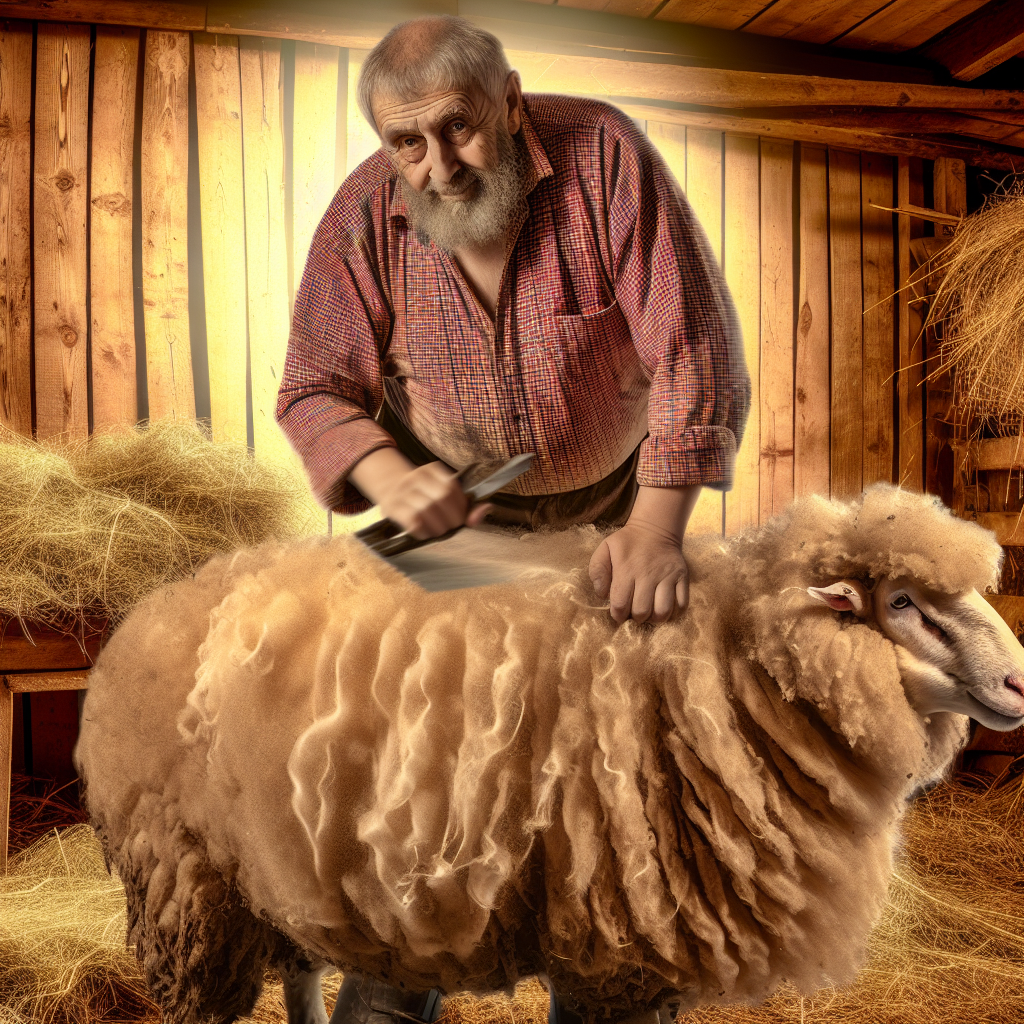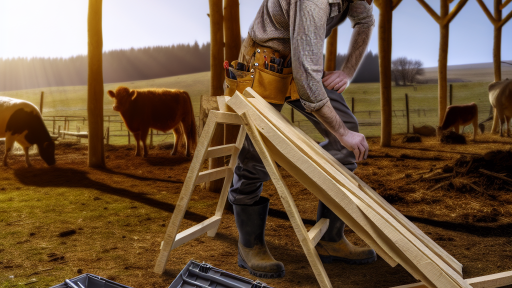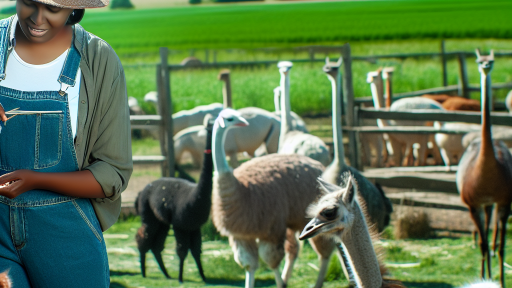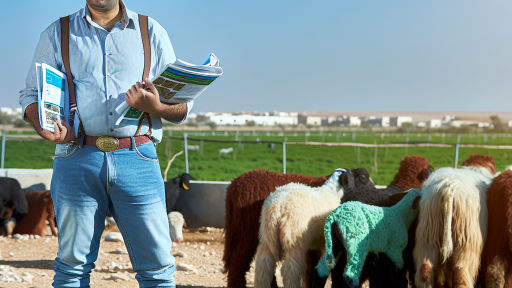Introduction to Sheep Shearing: Importance and Benefits
Sheep shearing is a vital practice in sheep farming.
This process helps maintain the health and well-being of sheep.
Shearing prevents overheating during warm months.
Moreover, it reduces the risk of wool parasites and diseases.
Wool harvesting generates an essential income stream for farmers.
High-quality wool serves various industries, producing textiles.
Overall, regular shearing enhances wool quality and yields.
Health Benefits for Sheep
Shearing promotes overall sheep welfare.
It improves hygiene by removing dirty and matted wool.
Cleansing the sheep’s skin decreases the likelihood of infections.
Furthermore, shearing helps in identifying skin issues early.
This proactive approach leads to healthier livestock.
Economic Advantages
Regular shearing significantly boosts the farmer’s profitability.
Quality wool fetches better prices in the market.
In addition, timely shearing allows for multiple shearings per year.
Transform Your Agribusiness
Unlock your farm's potential with expert advice tailored to your needs. Get actionable steps that drive real results.
Get StartedFarmers can diversify their income through wool-related products.
This practice enhances their financial sustainability.
Wool Quality and Market Demand
Proper shearing techniques contribute to superior wool quality.
Clean, well-sheared wool attracts higher market demand.
Strong market positions can be developed with consistent quality.
The wool must be collected carefully to maximize its value.
Farmers benefit from maintaining good relationships with buyers.
Understanding the Shearing Process
Importance of Sheep Shearing
Sheep shearing is a vital process for wool production.
It enhances sheep health and productivity.
Regular shearing prevents overheating in warmer months.
Moreover, it reduces the risk of flystrike.
Techniques for Effective Shearing
Effective shearing requires proper technique.
Start by securely holding the sheep to prevent movement.
Begin shearing at the belly and move towards the back.
Use short, deliberate strokes for best results.
Keep the blade angle consistent for even shearing.
Essential Tools for Shearing
Shearers need high-quality tools for optimal results.
A good pair of electric shears is essential.
Hand shears are useful for finishing touches.
Don’t forget to sharpen blades regularly.
Safety equipment like gloves and goggles is crucial.
Preparing for Shearing Day
Preparation ensures a smooth shearing process.
Choose a clean, dry area for shearing.
Gather all necessary tools beforehand.
Showcase Your Farming Business
Publish your professional farming services profile on our blog for a one-time fee of $200 and reach a dedicated audience of farmers and agribusiness owners.
Publish Your ProfileEnsure the sheep are healthy and clean.
Provide ample space for sheep to move freely.
The Best Time of Year for Shearing: Seasonal Considerations
Understanding the Seasons
Sheep shearing is best aligned with the seasons.
Winter coats trap heat, which sheep need to lose before warm weather.
Consequently, shearing in early spring is advantageous.
This timing helps sheep remain comfortable in rising temperatures.
Temperature and Weather Patterns
Weather patterns significantly influence shearing schedules.
Warm and dry conditions promote efficient shearing.
Wet or cold weather can lead to health issues for sheep.
Thus, always monitor forecasts before scheduling shearing days.
Health Considerations
Healthy sheep yield better quality wool.
Regular veterinary check-ups contribute to this wellness.
Before shearing, ensure your flock is free from parasites.
This preparation improves the overall quality of the shearing process.
Regional Variations
Consider your location when planning shearing dates.
Different regions experience varying climates, affecting optimal timing.
For instance, southern farmers may shear earlier than those in northern areas.
Hence, adapt your schedule to local climate trends.
Shearing and Breeding Cycles
Shearing affects breeding cycles, too.
Timing shearing in relation to breeding can optimize both wool quality and lambing.
Farmers should plan to shear after breeding but before lambing.
This strategy ensures ewes have energy for nursing their lambs.
Delve into the Subject: Scaling Your Fish Farm: From Small Start to Large Operation
Preparing Sheep for Shearing
Understanding the Importance of Preparation
Preparing sheep for shearing ensures their safety and comfort.
Proper preparation also enhances the quality of wool harvested.
General Handling Tips
Always handle sheep gently to reduce stress.
Approach them calmly and quietly, promoting a relaxed environment.
Use gentle pressure when guiding them to avoid accidents.
Health Checks Before Shearing
Conduct a health check to identify any issues before shearing.
Look for signs of illness, injury, or parasites.
Consult a veterinarian if any health concerns arise.
Creating a Comfortable Environment
Ensure the shearing area is clean and well-lit.
Provide adequate space to prevent overcrowding during shearing.
Keep the area free from loud noises and sudden movements.
Proper Handling Equipment
Use appropriate sheep handling equipment for safety.
Invest in quality tools, including sheep dogs if necessary.
Ensure that all equipment is clean and well-maintained.
Training for Handlers
Train all handlers in proper sheep handling techniques.
A well-trained handler minimizes stress for the sheep.
Consider workshops or practice sessions before the shearing day.
Showcase Your Farming Business
Publish your professional farming services profile on our blog for a one-time fee of $200 and reach a dedicated audience of farmers and agribusiness owners.
Publish Your ProfileFeeding and Hydration Before Shearing
Provide sheep with fresh water and proper nutrition before shearing.
Ensure they are well-fed to maintain their energy levels.
Monitor their condition leading up to the shearing event.
Delve into the Subject: Benefits Of Proper Livestock Waste Management
Health and Safety Measures for Farmers During Shearing
Importance of Personal Protective Equipment
Farmers must prioritize personal protective equipment during sheep shearing.
Wearing gloves protects hands from cuts and shearing equipment.
Additionally, padded vests reduce the risk of injury to the torso.
Farmers should also use sturdy footwear to prevent slips and falls.
Using ear protection is essential to shield against loud shearing noise.
Overall, proper gear enhances safety and comfort during the process.
Maintaining a Clean Work Environment
A clean work area is vital for safe shearing practices.
Farmers should regularly clean the shearing floor to remove debris.
Properly storing tools reduces hazards while working.
Moreover, ensuring good lighting helps identify potential risks.
By keeping the area organized, farmers can prevent accidents effectively.
Handling Sheep with Care
Careful handling of sheep significantly reduces stress for both parties.
Farmers should approach sheep calmly to minimize panic during shearing.
Using appropriate restraining techniques ensures the sheep remains still.
Farmers must watch for signs of distress and adjust techniques accordingly.
Furthermore, understanding the animal’s behavior aids in a smoother process.
Staying Hydrated and Taking Breaks
Staying hydrated is crucial for farmer well-being during long shearing sessions.
Farmers should regularly drink water, especially in warm conditions.
Taking breaks also helps to maintain focus and reduce fatigue.
Scheduling short breaks every hour can improve overall efficiency.
By balancing work and rest, farmers enhance their safety and performance.
Emergency Preparedness
Farmers should have an emergency plan in place for accidents.
Having a first-aid kit readily available is essential for quick responses.
Identifying emergency contacts and sharing them with the team is vital.
Additionally, undergoing first-aid training can prove invaluable.
Preparedness ensures farmers can act quickly during unforeseen incidents.
You Might Also Like: Emergency Procedures in Livestock Transportation

Aftercare of Sheep Post-Shearing: Best Practices
Providing Adequate Shelter
Immediately after shearing, provide adequate shelter for the sheep.
Sheep can become cold quickly without their wool protection.
Use barn spaces or windbreaks to shield them from harsh weather.
Ensure the shelter is dry and well-ventilated to promote health.
Monitoring Health
Regularly check the sheep for any signs of injury or distress.
Look for skin abrasions or cuts that may need treatment.
Keep an eye on their overall behavior and appetite.
Consider using a topical antiseptic on any minor wounds.
Providing Nutritional Support
Post-shearing, provide a balanced diet rich in nutrients.
Showcase Your Farming Business
Publish your professional farming services profile on our blog for a one-time fee of $200 and reach a dedicated audience of farmers and agribusiness owners.
Publish Your ProfileIncorporate higher energy feeds to support body recovery.
Offer fresh water at all times to keep them hydrated.
Consider adding minerals that promote wool regrowth and overall health.
Managing Pasture Quality
After shearing, ensure pastures are in good condition for grazing.
Monitor grass length and quality to maintain nutrition.
Rotate grazing areas to prevent overgrazing and allow regrowth.
Regularly check for any toxic plants that may harm the sheep.
Following Health Protocols
Maintain regular vaccination schedules to prevent disease outbreaks.
Implement parasite control measures at this time.
Consult with a veterinarian for specific health recommendations.
Facilitating Wool Recovery
Encourage a stress-free environment for the sheep to promote growth.
Avoid unnecessary handling that might cause stress.
Continue regular grooming to keep the skin healthy and free from debris.
Consider recording wool quality and condition for future evaluation.
Explore Further: Composting Livestock Waste A Farming Guide
Wool Quality and Grading: What Farmers Should Know
Understanding Wool Quality
Wool quality significantly influences farmers’ profitability.
High-quality wool commands better prices in the market.
Farmers should focus on key factors that determine wool quality.
These factors include fiber diameter, color, and strength.
Grading Wool
Grading wool involves assessing its quality characteristics.
Farmers must familiarize themselves with standard grading systems.
The American Wool Sheep Commission outlines several grades.
These grades range from fine wool to coarse wool types.
Fiber Diameter
The fiber diameter measures the thickness of individual wool fibers.
Finer fibers generally indicate higher quality wool.
Tools like the microscope help farmers accurately measure diameter.
Color Considerations
Wool color plays a vital role in determining market value.
Pure white wool is often preferred for dyeing processes.
Farmers should aim to breed sheep with desirable wool color.
Strength and Staple Length
Strong fibers resist breakage during processing and handling.
Farmers should assess wool strength through tensile testing.
Staple length refers to the length of wool fibers harvested.
Longer fibers usually yield better processing results.
Preparing Wool for Market
Proper preparation ensures wool meets market standards.
Farmers should clean and sort wool meticulously before selling.
Labeling is also essential, as it provides information on quality.
Market Trends and Consumer Preferences
Understanding market trends enhances farmers’ selling strategies.
Consumers increasingly prefer sustainably sourced wool products.
Farmers should adopt eco-friendly practices to appeal to buyers.
Marketing and Selling Wool: Strategies for Farmers
Understanding Your Market
First, identify potential buyers for your wool products.
Showcase Your Farming Business
Publish your professional farming services profile on our blog for a one-time fee of $200 and reach a dedicated audience of farmers and agribusiness owners.
Publish Your ProfileResearch local artisans who use wool for crafts and apparel.
Next, explore larger manufacturers seeking quality wool supplies.
Consider joining wool marketing associations for additional resources.
Branding Your Wool Products
Develop a strong brand identity to stand out in the market.
Create a logo that reflects the quality and uniqueness of your wool.
Use storytelling to convey your farming practices and values.
Highlight the ethical and sustainable aspects of your wool production.
Utilizing Online Platforms
Establish an online presence through a dedicated website.
Utilize social media platforms to showcase your wool products.
Engage with potential customers by sharing informative content.
Consider setting up an online store for direct sales.
Participating in Local Markets
Join farmers’ markets to sell your wool directly to consumers.
Network with other farmers and artisans at these events.
Offer samples to attract attention and foster customer interest.
Participate in community fairs to expand your reach.
Building Relationships with Buyers
Establish strong relationships with your buyers for better sales.
Communicate regularly to understand their needs and preferences.
Offer incentives such as discounts for bulk purchases.
Solicit feedback to improve your offerings and maintain loyalty.
Exploring Value-Added Products
Consider creating value-added products from your wool.
Items such as yarn, felt, and wool insulation can increase profits.
Collaborate with local artisans to create unique wool products.
Market these products as premium offerings to attract higher prices.
Staying Informed on Industry Trends
Regularly research trends in the wool market to stay competitive.
Subscribe to industry newsletters and attend wool conferences.
Follow market prices to time your sales for maximum profit.
Adapt your business strategies based on evolving consumer preferences.
Additional Resources
Sheep Best Management Practices – Cooperative Extension: Livestock




